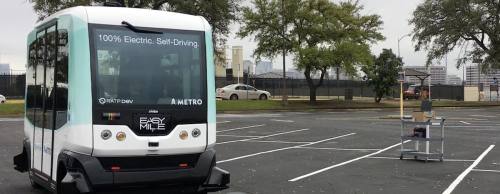 The Easy Mile EZ10 can hold six seated passengers and six standing passengers and travels at 8 mph.[/caption]
Iannello said autonomous shuttles could play a part in the rollout of Capital Metro’s 10-year service plan called Connections 2025 that board members approved Feb. 20.
“[Connections 2025] also talks about innovation zones—the first and last mile,” he said. “This type of technology can play right into that in terms of one of the ways the first and last mile may be connected to public transit and mass transit.”
Capital Metro is already using some autonomous technology on its buses for collision avoidance, Iannello said. However, using autonomous shuttles is still a few years out, he said.
The demonstration is a partnership between Capital Metro and RATP DEV, the parent company of McDonald Transit, which has operated the agency’s fixed bus routes since 2012.
The Easy Mile EZ10 fully autonomous shuttle operates on a preprogrammed path at 8 mph. It holds six seated passengers and six standing passengers. The shuttle is equipped with object-detection technology using cameras and radar that scans the area surrounding the shuttle, said Vasilis Karavidas, a deployment engineer with Easy Mile.
Other cities that use autonomous shuttles include San Francisco, Tokyo and Singapore as well as some in France and Holland, Karavidas said. The vehicle is similar to a tram and is primarily used to connect neighborhoods with transit and travel places that buses or larger vehicles cannot, he said.
Capital Metro also has a partnership with UT’s Center for Transportation Research, which is analyzing how autonomous vehicles factor into the future of public transit, CTR Director Chandra Bhat said.
“The question for us is how will public transportation morph, and we can see plenty of ways public transportation can complement,” he said. “With [autonomous] vehicles every time you call on one it becomes a ‘kiss and ride.’ You don’t have to park or walk because it takes you to your destination. It’s more seamless, which can be attractive.”
The Easy Mile EZ10 can hold six seated passengers and six standing passengers and travels at 8 mph.[/caption]
Iannello said autonomous shuttles could play a part in the rollout of Capital Metro’s 10-year service plan called Connections 2025 that board members approved Feb. 20.
“[Connections 2025] also talks about innovation zones—the first and last mile,” he said. “This type of technology can play right into that in terms of one of the ways the first and last mile may be connected to public transit and mass transit.”
Capital Metro is already using some autonomous technology on its buses for collision avoidance, Iannello said. However, using autonomous shuttles is still a few years out, he said.
The demonstration is a partnership between Capital Metro and RATP DEV, the parent company of McDonald Transit, which has operated the agency’s fixed bus routes since 2012.
The Easy Mile EZ10 fully autonomous shuttle operates on a preprogrammed path at 8 mph. It holds six seated passengers and six standing passengers. The shuttle is equipped with object-detection technology using cameras and radar that scans the area surrounding the shuttle, said Vasilis Karavidas, a deployment engineer with Easy Mile.
Other cities that use autonomous shuttles include San Francisco, Tokyo and Singapore as well as some in France and Holland, Karavidas said. The vehicle is similar to a tram and is primarily used to connect neighborhoods with transit and travel places that buses or larger vehicles cannot, he said.
Capital Metro also has a partnership with UT’s Center for Transportation Research, which is analyzing how autonomous vehicles factor into the future of public transit, CTR Director Chandra Bhat said.
“The question for us is how will public transportation morph, and we can see plenty of ways public transportation can complement,” he said. “With [autonomous] vehicles every time you call on one it becomes a ‘kiss and ride.’ You don’t have to park or walk because it takes you to your destination. It’s more seamless, which can be attractive.”
Select your community
Support Us
News
- Austin Metro
-
Houston Metro
- Houston Metro Home
- Bay Area
- Bellaire | Meyerland | West University
- Conroe | Montgomery
- Cy-Fair | Jersey Village
- Cypress
- Heights | River Oaks | Montrose
- Katy | Fulshear
- Lake Houston | Humble | Kingwood
- New Caney | Porter
- Pearland | Friendswood | Manvel
- Spring | Klein
- Sugar Land | Missouri City
- The Woodlands
- Tomball | Magnolia
- Dallas | Fort Worth Metro
- San Antonio Metro





